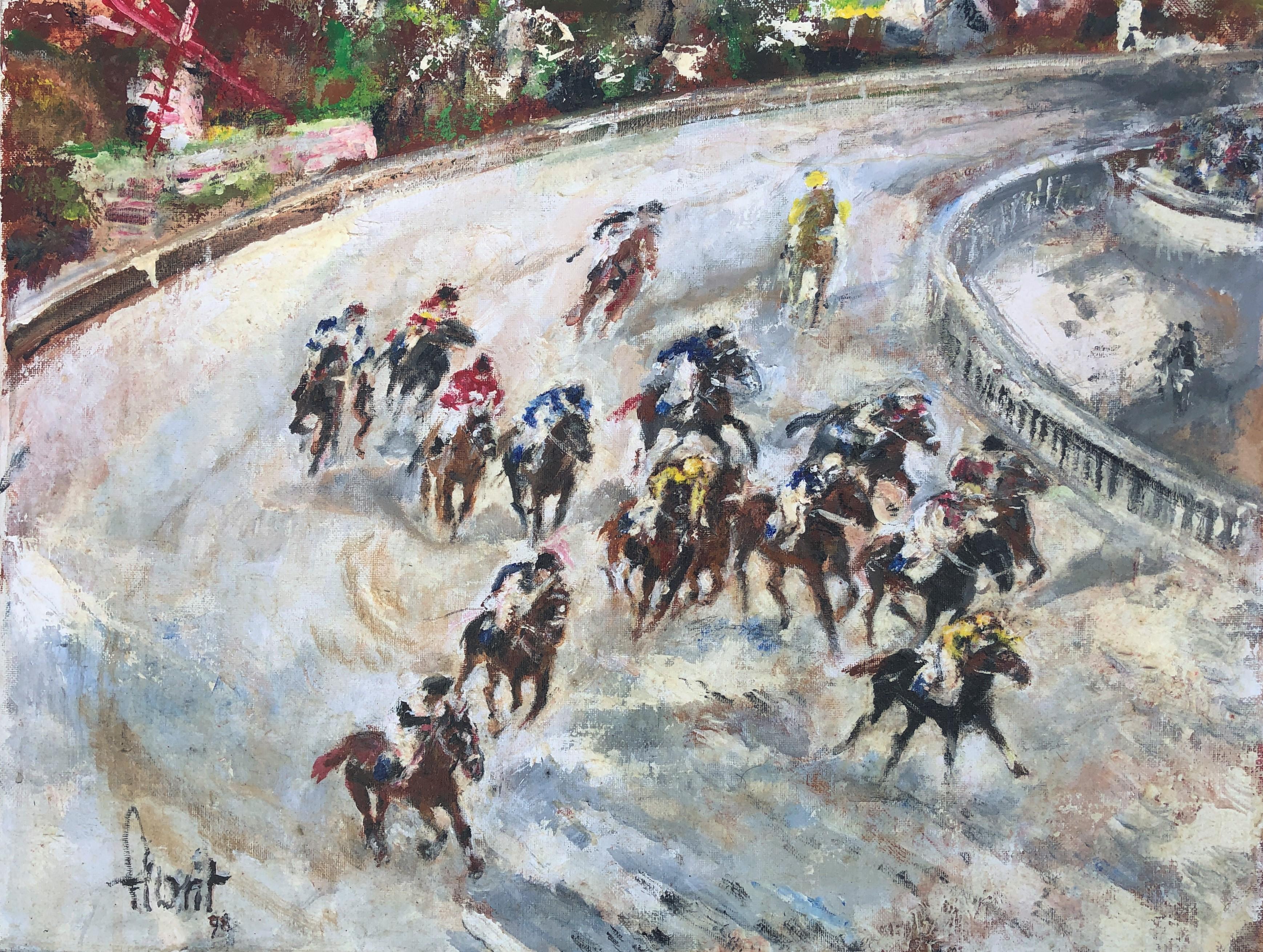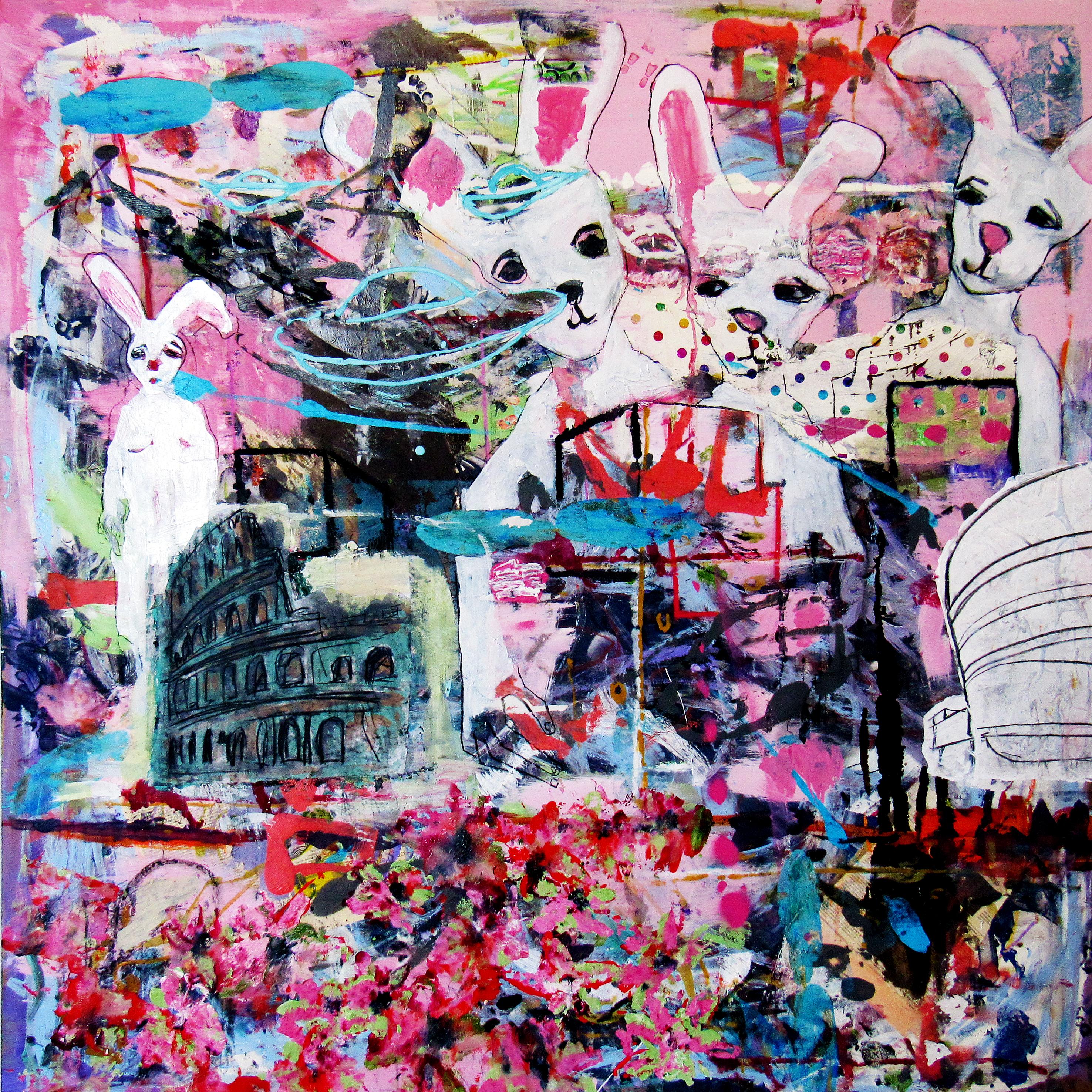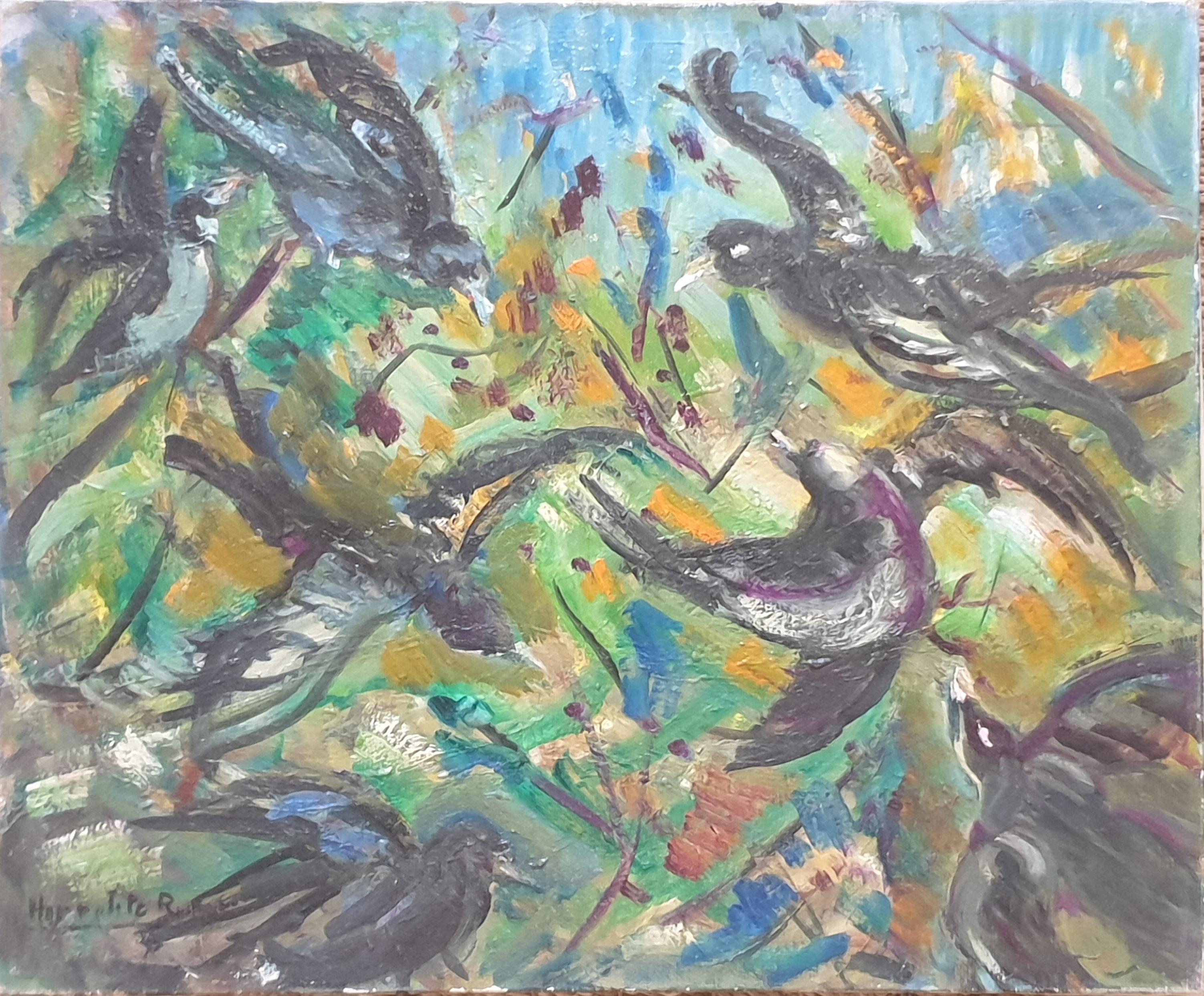Items Similar to White Angora Cats
Want more images or videos?
Request additional images or videos from the seller
1 of 8
Arthur HeyerWhite Angora Cats
About the Item
Arthur Heyer
German, 1872 – 1931
White Angora Cats
Oil on canvas
22 by 27 in. w/frame 30 by 35 in.
Arthur Heyer was born in Haarhausen. He studied at the college of applied arts in Berlin. In 1896 he went into exile in Rakospalota, near Budapest and eventually settled there permanently. He began by painting landscapes and then developed into an animal painter, with a particular attraction for cats. He provided illustrations for books produced by the Franklinische Verlag, which specialized in books about animals. He also worked for Shver’s Familieblatt (Shver’s Family Magazine) and Uber Land und Meer (Over Land and Sea).
Provenance:
Private Collection, New York
Le Trianon Fine Art & Antiques, Sheffield, MA.
Art H18
$4,500
- Creator:Arthur Heyer (1872 - 1931, German, Hungarian)
- Dimensions:Height: 30 in (76.2 cm)Width: 35 in (88.9 cm)Depth: 2 in (5.08 cm)
- Medium:
- Movement & Style:
- Period:
- Condition:
- Gallery Location:Sheffield, MA
- Reference Number:
About the Seller
3.7
Vetted Seller
These experienced sellers undergo a comprehensive evaluation by our team of in-house experts.
1stDibs seller since 2017
46 sales on 1stDibs
Typical response time: Several days
- ShippingRetrieving quote...Ships From: Sheffield, MA
- Return PolicyThis item cannot be returned.
More From This SellerView All
- Winter Landscape With DeerBy Clemens FreitagLocated in Sheffield, MAClemens Freitag German, 1882/83-1969 Winter Landscape With Deer Oil on canvas 35 by 50 in. W/frame 45 by 60 in. Signed lower right Landscape and...Category
1920s Naturalistic Landscape Paintings
MaterialsOil
- Flower Market, La Madeleine, ParisBy Antoine BlanchardLocated in Sheffield, MAAntoine Blanchard French, 1910-1988 Flower Market, La Madeleine, Paris Oil on canvas 13 by 18 in. W/frame 19 by 24 in. Signed lower right Provenance: Catalda Fine Arts, Inc., New York Private Collection, New York Trinity House Paintings, London Private Collcetion, New York Alexander Avenard Collection Le Trianon...Category
Mid-20th Century Post-Impressionist Landscape Paintings
MaterialsOil
- BathersBy John Edward CostiganLocated in Sheffield, MAJohn Edward Costigan, N.A. American, 1888-1972 Bathers Oil on canvas Signed ‘J.E. Costigan N.A.’ lower left 20 by 24 in. W/frame 26 by 30 in. John Costigan was born of Irish-American parents in Providence, Rhode Island, February 29, 1888. He was a cousin of the noted American showman, George M. Cohan, whose parents brought the young Costigan to New York City and was instrumental in starting him on a career in the visual arts. They were less successful in encouraging him to pursue formal studies at the Art Students League (where, however, he later taught) than in exposing him to the commercial art world through the job they had gotten him with the New York lithographing firm that made their theatrical posters. At the H. C. Miner Lithographing Company, Costigan worked his way up from his entry job as a pressroom helper, through various apprenticeships, to the position of sketch artist. In the latter capacity he was an uncredited designer of posters for the Ziegfeld Follies and for numerous silent films. Meanwhile, he had supplemented his very meager formal studies in the fine arts with a self-teaching discipline that led to his first professional recognition in 1920 with the receipt of prizes for an oil painting and watercolor in separate New York exhibitions. A year earlier, Costigan had wed professional model Ida Blessin, with whom he established residence and began raising a family in the sleepy little rural New York hamlet of Orangeburg, the setting for the many idyllic farm landscapes and wood interiors with which he was to become identified in a career that would span half a century. John Costigan’s first national recognition came in 1922 with his winning of the coveted Peterson Purchase prize of the Art Institute of Chicago for an oil on canvas, “Sheep at the Brook.” It marked the start of an unbroken winning streak that would gain him at least one important prize per year for the remainder of the decade. The nation’s art journalists and critics began to take notice, making him the recurring subject of newspaper features and magazine articles. The eminent author and critic Edgar Holger Cahill was just a fledgling reporter when he wrote his first feature, “John Costigan Carries the Flame,” for Shadowland Magazine in 1922. Costigan had his first one-man show of paintings at the Rehn Gallery on New York’s 5th Avenue in November, 1924, to be followed less than three years later by another at the Art Institute of Chicago. In addition, Costigan’s work has been—and continues to be included, side-by-side with that of some of America’s most high-profile artists, in museum and gallery exhibitions throughout the country. His renown had peaked in the early 1930s, by which time his work had been honored with nearly every major award then being bestowed in the fine arts and had been acquired for the permanent collections of several prestigious American museums, including New York’s Metropolitan (which only recently, in 1997, deaccessioned his “Wood Interior,” acquired in 1934). Although Costigan’s celebrity had ebbed by the late 1930s, the Smithsonian Institution saw fit in 1937 to host an exhibition exclusively of his etchings. And, in 1941, the Corcoran Gallery (also Washington, D.C.) similarly honored him for his watercolors. (Another Washington institution, the Library of Congress, today includes 22 Costigan etchings and lithographs in its permanent print collection.) During World War II, Costigan returned briefly to illustrating, mainly for Bluebook, a men’s pulp adventure magazine. A gradual revival of interest in his more serious work began at the end of the war, culminating in 1968 with the mounting of a 50-year Costigan retrospective at the Paine Art Center and Arboretum in Oshkosh, Wisconsin. Oils, watercolors and prints were borrowed from museums and private collections throughout the country, and the exhibition was subsequently toured nationally by the Smithsonian Institution. John Costigan died of pneumonia in Nyack, NY, August 5, 1972, just months after receiving his final prestigious award —the Benjamin West Clinedinst Medal of the Artist’s Fellowship, Inc., presented in general recognition of his “...achievement of exceptional artistic merit...” in the various media he had mastered in the course of his career. This painting depicts one of the artist's favorite themes --the farm family bathing...Category
1950s Post-Impressionist Figurative Paintings
MaterialsOil
- Montmartre -La Place Dutertre, Paris 1952By Jean SalabetLocated in Sheffield, MAJean Salabet French, 20th Century Montmartre Jean Salabet was a School of Paris painter know for his colorful Parisian cityscapes. His work is comparable to those of Jules Herve, An...Category
1950s Post-Impressionist Landscape Paintings
MaterialsOil
- Woman and ChildBy John Edward CostiganLocated in Sheffield, MAJohn Edward Costigan, N.A. American, 1888-1972 Woman and Child Oil on canvas Signed ‘J.E. Costigan N.A.’ lower left 24 by 30 in. W/frame 32 by 38 in. John Costigan was born of Irish-American parents in Providence, Rhode Island, February 29, 1888. He was a cousin of the noted American showman, George M. Cohan, whose parents brought the young Costigan to New York City and was instrumental in starting him on a career in the visual arts. They were less successful in encouraging him to pursue formal studies at the Art Students League (where, however, he later taught) than in exposing him to the commercial art world through the job they had gotten him with the New York lithographing firm that made their theatrical posters. At the H. C. Miner Lithographing Company, Costigan worked his way up from his entry job as a pressroom helper, through various apprenticeships, to the position of sketch artist. In the latter capacity he was an uncredited designer of posters for the Ziegfeld Follies and for numerous silent films. Meanwhile, he had supplemented his very meager formal studies in the fine arts with a self-teaching discipline that led to his first professional recognition in 1920 with the receipt of prizes for an oil painting and watercolor in separate New York exhibitions. A year earlier, Costigan had wed professional model Ida Blessin, with whom he established residence and began raising a family in the sleepy little rural New York hamlet of Orangeburg, the setting for the many idyllic farm landscapes and wood interiors with which he was to become identified in a career that would span half a century. John Costigan’s first national recognition came in 1922 with his winning of the coveted Peterson Purchase prize of the Art Institute of Chicago for an oil on canvas, “Sheep at the Brook.” It marked the start of an unbroken winning streak that would gain him at least one important prize per year for the remainder of the decade. The nation’s art journalists and critics began to take notice, making him the recurring subject of newspaper features and magazine articles. The eminent author and critic Edgar Holger Cahill was just a fledgling reporter when he wrote his first feature, “John Costigan Carries the Flame,” for Shadowland Magazine in 1922. Costigan had his first one-man show of paintings at the Rehn Gallery on New York’s 5th Avenue in November, 1924, to be followed less than three years later by another at the Art Institute of Chicago. In addition, Costigan’s work has been—and continues to be included, side-by-side with that of some of America’s most high-profile artists, in museum and gallery exhibitions throughout the country. His renown had peaked in the early 1930s, by which time his work had been honored with nearly every major award then being bestowed in the fine arts and had been acquired for the permanent collections of several prestigious American museums, including New York’s Metropolitan (which only recently, in 1997, deaccessioned his “Wood Interior,” acquired in 1934). Although Costigan’s celebrity had ebbed by the late 1930s, the Smithsonian Institution saw fit in 1937 to host an exhibition exclusively of his etchings. And, in 1941, the Corcoran Gallery (also Washington, D.C.) similarly honored him for his watercolors. (Another Washington institution, the Library of Congress, today includes 22 Costigan etchings and lithographs in its permanent print collection.) During World War II, Costigan returned briefly to illustrating, mainly for Bluebook, a men’s pulp adventure magazine. A gradual revival of interest in his more serious work began at the end of the war, culminating in 1968 with the mounting of a 50-year Costigan retrospective at the Paine Art Center and Arboretum in Oshkosh, Wisconsin. Oils, watercolors and prints were borrowed from museums and private collections throughout the country, and the exhibition was subsequently toured nationally by the Smithsonian Institution. John Costigan died of pneumonia in Nyack, NY, August 5, 1972, just months after receiving his final prestigious award —the Benjamin West Clinedinst Medal of the Artist’s Fellowship, Inc., presented in general recognition of his “...achievement of exceptional artistic merit...” in the various media he had mastered in the course of his career. This painting depicts one of the artist's favorite themes --the farm family bathing...Category
1940s Post-Impressionist Landscape Paintings
MaterialsOil
- Marche de Fleurs, a La Madeleine Paris 1954By Jean SalabetLocated in Sheffield, MAJean Salabet French, 20th Century Marche de Fleurs, La Madeleine Paris Jean Salabet was a School of Paris painter know for his colorful Parisia...Category
1950s Post-Impressionist Landscape Paintings
MaterialsOil
You May Also Like
- 20thC Modernist oil ' Dog in the Midday Sun' circa 1980Located in Frome, SomersetA fine 20th Century Modernist figurative oil painted by Christian Pedersen Bellinge (1897-1984) oil on canvas 60cm x 70cm painted wooden frame 68cmx 78cm A good late work by the well...Category
1980s Post-Impressionist Landscape Paintings
MaterialsOil
- Horse race oil on canvas paintingBy Jose Luis Florit RoderoLocated in Barcelona, BarcelonaJosé Luis Florit Rodero (Madrid, 1909-Paris, 2000). Draftsman and painter. Trained in Olot and Figueras, he was guided in his early years by Juan Núñe...Category
1990s Fauvist Animal Paintings
MaterialsOil, Canvas
- plowing with oxen oil on board painting SpainBy Juan SolerLocated in Barcelona, BarcelonaOil measures 30x30 cm. Frame measures 52x52 cm. He was born in 1951. Under the direction of the teacher Pedro Bermejo, he began his artistic career, quickly standing out and observing in his works an unusual mastery of drawing. A highly mature painter who has known how to stop time in all his works. His themes are preferably costumbrist, although in his work it is usual to see 18th century themes, with horse carriages, hats, umbrellas and still lifes. Observing his work reminds us, due to the theme, of Maestro Palmero...Category
21st Century and Contemporary Post-Impressionist Animal Paintings
MaterialsOil, Board
- Rabbits in Rome, colorful abstract with rabbits, architecture, hot pink blueBy C. DimitriLocated in Brooklyn, NYA narrative landscape, suggesting a collision of art, history, and phantasm. Oil paint, collage, mixed media on panel. references Guggenheim, Roman colosseumCategory
2010s Fauvist Animal Paintings
MaterialsMixed Media, Oil, Panel
- Swallows in Flight, French Mid-Century Oil on Canvas.Located in Cotignac, FRFrench Mid 20th Century oil on canvas Fauvist painting of swallows in flight by Hyppolite Roger. The painting is signed bottom left and also to the bac...Category
Mid-20th Century Fauvist Animal Paintings
MaterialsCanvas, Oil
- Antique Animal Painting "Shepherd Boy with Calf, Goat, Kid, Lamb and Dog"Located in SANTA FE, NMAntique Animal Painting "Shepherd Boy at Rest with Calf, Goat, Kid, Lamb and Dog" Julius Paul Junghanns (1876 - 1958) Oil on canvas 29 x 23 1/...Category
Early 20th Century Post-Impressionist Animal Paintings
MaterialsCanvas, Oil



